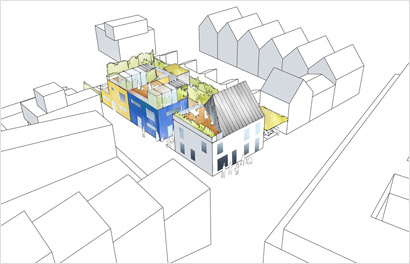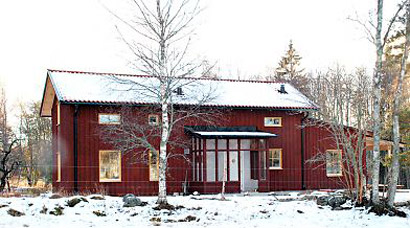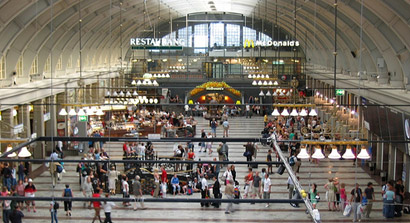RESOURCES
5-144000
A
B
C
D
E
F
G
H
I
J
K
L
M
N
O
P
Q
R
S
T
U
V
W
Y
Z
|
|

|
Swedes active about passive houses
Posted by Lev/Christopher on December 8, 2009 at 7:30am
in Scandinavian Group
Passive houses are the hottest trend among Swedish environmentalists.
These ultra-low energy buildings rely on recycled heat and high-level
insulation for most of their power needs. Hence “passive” — they
require less active contribution of external energy sources.

Malmö's Västra Hamnen is an eco-area where new passive houses are being built. Illustration: Kjellgren Kaminsky Architecture
The first passive houses were built in Germany, but a Swede, Bo
Adamson, professor at Lund University, participated in the original
concept. And Swedes, forever on the lookout for ways to make their
society more sustainable, have embraced the idea. The total energy
consumption of passive houses in Sweden is below 45 kilowatt hours per
year — a quarter of ordinary houses.
Joakim Kaminsky is an architect at Kjellgren Kaminsky Architecture, a
company for which passive houses make up more than 50 percent of the
order books. “Passive house construction is growing exponentially in
Sweden,” he says.
So far, there are about 1,000 passive homes in Sweden, compared with
around 6,000 in Europe and 15,000 worldwide. A passive house is not a
specific technology, but a standard. Keep the energy consumption
ultra-low, and you can call your house passive. But recent technologies
help, favoring new buldings.
Eco-living on the rise
Swedish winters are cold, and it can cost SEK 3,000 (around USD 430) or
more per month to heat a home. Carl-Gustaf Degerhammar and his wife,
Anne Beth, did their sums before renting an apartment in a recently
completed passive house apartment block in Västra Hamnen (the western
harbor) in the southern Swedish city of Malmö, a “laboratory” for new
environmental technology.
“It’s exciting for us to contribute to a sustainable environment, and
also to lower the cost of heating,” Anne Beth says. “In the future,
heating costs will go up, but for us it will still cost the same. It’s
like an insurance policy against higher energy prices.”
Carl-Gustaf adds: “It's our contribution to the environment. We can
decide how much we want to consume in heating the apartment.”
The walls in their apartment are thick, and the floors and windows are
double-glazed. Hot air from any source in the building is recycled,
especially from lamps and cooking, and channeled through thick pipes
into a heat exchanger used to keep the apartment warm.
Recent large projects include one by construction giant Skanska, which
calls itself market leader for passive houses, refurbishing 300
existing apartments in Alingsås in south-western Sweden to passive
house standards, and the Göteborg municipality has already built 400
passive homes.
Facing a cold reality

Villa Westholm in Falun is Sweden's northernmost passive house. Architects: Efem Arkitektkontor AB. Photo: Åsa Johansson
At the outset, passive houses were supposed to do without extra heating
altogether. But that ideal was based on Germany’s comparably mild
climate. Swedes face a snag: Sweden has two climate zones. While Malmö
and Göteborg have a winter climate comparable to much of Germany, it’s
a different ball game further north, where temperatures routinely drop
to minus 10, 20 or 30 degrees Celsius (50, 68 or 86 degrees Fahrenheit).
Studies have indicated that it costs 15 percent more to build a passive
house in northern Sweden than in the south. This is in addition to the
5-15 percent extra cost that passive house builders already face
compared with a conventional home. But the truth is that nobody really
knows for sure. The northernmost passive house in Sweden stands in
Falun in Dalarna county. A very northern place by European standards,
but for Sweden? Not even half way up the country.
“In Sweden it’s almost impossible to do without some kind of additional
heating,” Kaminsky says. And that, he says, is a problem for many
environmentally conscious house owners who want to avoid electrical
heating fueled by nuclear or other non-renewable sources. Solar panels
are a solution to cover part of the remaining energy needs, as are
stoves fired with wooden pellets, or simply district heating, a system
for distributing heat generated in a centralized location. '
Not just about money
In most cases the higher initial building cost can be offset from lower
energy bills over five or ten years. Cost savings are important, but
the idea of protecting the environment is never far behind.
Environmentalists say buildings are responsible for half of the world’s
greenhouse emissions, a worry that prompted Malmö’s World Trade Center
(WTC), a large office building, to go as energy-efficient as possible.
WTC doesn’t reach passive house standards, but is still considered to
be the most energy-efficient office building in the world. Blinds go up
and down all day long, keeping out the sun’s heat, because cooling is
the biggest problem for office buildings, explains Rikard Sjöqvist, the
WTC’s chief engineer. “I believe that almost every office building
being built in Sweden in the next two or three years is going to have a
similar engineering system,” he predicts.
Commuters to heat offices?
And the hunt for energy-efficient solutions leads some unusual ideas.
Stockholm’s central rail station, one of the biggest and busiest in
northern Europe, is also getting in on the act, using body heat emitted
by the station's 250,000 daily commuters to help heat an adjacent
office building.

Can the bodies passing through Stockholm's central station really heat an office building? Photo: Annona/Flickr
At the moment, the station’s temperature is over 85 degrees Fahrenheit
(30 degrees Celsius) at ceiling height. “We actually cool this building
quite a lot,” says Karl Sundström, an engineer working for station
owners Jernhuset. ”So we’ll take the energy instead and move it to the
new building.” Water warmed with hot air will be pumped into the office
block, pushing its heating bill down by a third.
Not quite passive standard, but half-way there and enough to show that
when it comes to energy savings, Swedes are active, even if they’re not
always exactly passive. Go figure.
http://www.sweden.se/eng/Home/Work-live/Sustainability/Reading/Swed...
|


This page was created on 5 May 2010
Updated on 5 May 2010
Copyright © 1987-2010 NCCG - All Rights Reserved
|
|


